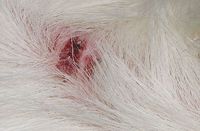Trixacarus
| This article is still under construction. |
| Also known as: | Selnick mite |
Trixacarus mites are burrowing mites of rodents. They cause Trixacaral mange, particularly in guinea pigs.
Identification
The mites are similar to Sarcoptes mites, but half the size. The mites can be identified from Notoedres' mites by their prominent sharp dorsal spines.
Life cycle
Trixacarus mites have a 3 week life cycle and can only survive a few weeks off the host. They are species specific and can be transmitted through direct contact, particularly through close contact between mother and offspring.
Infection
The mites cause severe pruritus in laboratory rodents and guinea pigs. Their burrowing activity causes biting, scratching and irritation. This leads to to inflammation, pruritus and alopecia. Affected areas show acanthosis and hyperkeratosis. Death can occur within 3-4 months of infection if it is not treated.
Diagnosis
Mite infection can be diagnosed by clinical signs and a skin scrape of a 'non-scratched' region.
Important Species
Trixacarus caviae- This species causes mange in guinea pigs.
Trixacarus diversus- This species causes mange in rats, mice and hamsters.
